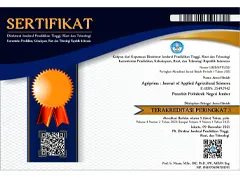Analisis Histologi dan Scaning Elektron Mikroskopy (SEM) pada Somatik Embriogenesis Tanaman Porang (Amorphophallus muelleri B)
DOI:
10.25047/agriprima.v6i1.450Downloads
Abstract
Pembentukan Somatik Embriogenesis (SE) porang secara tidak langsung memiliki proses yang lambat, selama ini yang digunakan adalah induksi secara langsung karena dapat mempercepat penyediaan bibit tetapi pengetahuan tentang induksi SE secara tidak langsung sangat dibutuhkan untuk mengetahui tahapan perkembangannya. Kami menyajikan pengetahuan terkait interaksi hormon 2,4-D dan NAA terhadap induksi kalus, histologi dan scanning elektron microscop (SEM) kalus embriogenik tanaman porang (Amorphophallus muelleri). Tujuan penelitian ini adalah guna mengetahui interaksi pengaruh 2,4-D dan NAA dalam proses induksi SE dan mempelajari tahapan perubahan embrio serta perkembangan struktur embrio tanaman porang. Penelitian ini telah dilangsungkan selama 6 bulan sejak Mei hingga Oktober 2021. Tempat penelitian berada di Laboratorium Kultur Jaringan Agronomi Fakultas Pertanian Universitas Jember. Penelitian ini mengunakan Rancangan Acak Lengkap (RAL) 2 Faktor dengan 3 kali ulangan. Faktor pertama ialah hormon 2,4-D dengan konsentrasi 0 ppm, 1 ppm, 2 ppm, dan faktor kedua yaitu hormon NAA dengan konsentrasi 0,5 ppm, 1 ppm, 1,5 ppm, 2 ppm, 2,5 ppm, kemudian data yang didapatkan dilakukan analisis deskriptif dan ANOVA. Hasil penelitian menunjukan perlakuan hormon 1 ppm 2,4-D dan 1,5 ppm NAA menghasilkan kalus embriogenik dan pada hasil histologi dan scaning electron mikroskopy (SEM) memperlihatkan tahapan embrio somatik porang meliputi tahapan proembrio, embrio globular, skutelar dan kolioptilar, lalu tahap koleoptilar berkembang ke tahap primodial tunas. Pada konsentrasi 1 ppm 2,4-D dan 1,5 ppm NAA terbentuk proembrio dan embrio globular yang memiliki permukaan proembrio yang halus.
Keywords:
Amorphophallus mulleri, Porang, Histologi, somatik embriogenesis, Scaning elektron mikroskopiReferences
A’yun, Q. (2019). The Selection Technique Of Bulbil Porang (Amorphophallus Muelleri Blume) Based On Growth Response. Journal of Environmental Engineering and Sustainable Technology, 6(1), 30–35. http://jeest.ub.ac.id
Abe, T., & Futsuhara, Y. (1985). Efficient plant regeneration by somatic embryogenesis from root callus tissue of rice (Oryza sativa L.). J. Plant Physiol, 121, l. https://doi.org/10.1016/S0176-1617(85)80035-3 DOI: https://doi.org/10.1016/S0176-1617(85)80035-3
Abe, T., & Futsuhara, Y. (1989). Selection of higher regenerative callus and change in isozyme pattern in rice (Oryza sativa L.). Theoretical and Applied Genetics, 78(5), 648–652. https://doi.org/10.1007/BF00262559 DOI: https://doi.org/10.1007/BF00262559
Barua, S., Tudu, K., Rakshit, M., & Srivastav, P. P. (2021). Characterization and digestogram modeling of modified elephant foot yam (Amorphophallus paeoniifolius) starch using ultrasonic pretreated autoclaving. Journal of Food Process Engineering, e13841. https://doi.org/10.1111/jfpe.13841 DOI: https://doi.org/10.1016/j.lwt.2021.111283
Carsono, N., Juwendah, E., Liberty, Sari, S., Damayanti, F., & Rachmadi, M. (2021). Optimize 2,4-D concentration and callus induction time enhance callus proliferation and plant regeneration of three rice genotypes. Biodiversitas, 22(7), 2555–2560. https://doi.org/10.13057/biodiv/d220702 DOI: https://doi.org/10.13057/biodiv/d220702
Chahal, P., Tummala, R. R., Allen, M. G., & Swaminathan, M. (1998). A novel integrated decoupling capacitor for MCM-L technology. IEEE Transactions on Components, Packaging, and Manufacturing Technology: Part B, 21(2), 184–193. https://doi.org/10.1109/96.673707 DOI: https://doi.org/10.1109/96.673707
de Araújo Silva‐Cardoso, I. M., Meira, F. S., Gomes, A. C. M. M., & Scherwinski‐Pereira, J. E. (2020). Histology, histochemistry and ultrastructure of pre‐embryogenic cells determined for direct somatic embryogenesis in the palm tree Syagrus oleracea. Physiologia Plantarum, 168(4), 845–875. https://doi.org/10.1111/ppl.13026 DOI: https://doi.org/10.1111/ppl.13026
Donowarti, I., Widjanarko, S. B., Yunianta, Y., & Pudjiastuti, P. (2021). Acute Toxicity Test Of Low Calcium Oxalate Porang (Amorphophallus Mueleri Blume) Flour. IRAQI JOURNAL OF AGRICULTURAL SCIENCES, 52(1), 218–231. https://doi.org/10.36103/ijas.v52i1.1253 DOI: https://doi.org/10.36103/ijas.v52i1.1253
Gurme, S. T., Jadhav, P. P., Pawar, K. D., Bapat, V. A., & Jadhav, J. P. (2018). Somatic embryogenesis and evaluation of genetic fidelity in Amorphophallus paeoniifolius (Dennst.) Nicolson. Journal of Crop Improvement, 32(6), 801–811. https://doi.org/10.1080/15427528.2018.1528193 DOI: https://doi.org/10.1080/15427528.2018.1528193
Harijati, N., & Mastuti, R. (2014). Estimation of diverse porang (Amorphophallus muelleri Blume) age in forest are based on brancing pattern of leaf petiolule. Research Journal of Life Science, 1(1), 20–26. https://doi.org/10.21776/ub.rjls.2014.001.01.4 DOI: https://doi.org/10.21776/ub.rjls.2014.001.01.4
Hernández-Piedra, G., Ruiz-Carrera, V., Sánchez, A. J., Hernández-Franyutti, A., & Azpeitia-Morales, A. (2018). Morpho-histological development of the somatic embryos of Typha domingensis. PeerJ, 6, e5952. https://doi.org/:10.7717/peerj.5952 DOI: https://doi.org/10.7717/peerj.5952
Hidayat, R., & Purwadi, P. (2021). Pengembangan Inovasi Pembibitan Porang (Amarphopallus Onchophillus L.) di Desa Panglungan, Kecamatan Wonosalam, Kabupaten Jombang. Prosiding Seminar Nasional Fakultas Pertanian UNS, 5(1), 495–508.
Ibrahim, M. S. D. (2019). Perbanyakan Iles-Iles (Amorphophallus Spp.) Secara Konvensional Dan Kultur In Vitro Serta Strategi Pengembangannya Conventional Propogation and In Vitro Culture of Iles-Iles (Amorphophallusspp.) and Its Development Strategy. Perspektif, 18(1), 67–78. http://dx.doi.org/10.21082/psp.v18n1.2019.67-78 DOI: https://doi.org/10.21082/psp.v18n1.2019.67-78
Kartini, M. (2017). Pengaruh Thidiazuron Dan Hidrolisat Kasein Terhadap Multiplikasi Tunas Satoimo (Colocasia Esculenta (L.) Schott Var Antiquorum) Secara In Vitro. Jurnal Bioteknologi & Biosains Indonesia (JBBI), 4(2), 70–77. https://doi.org/10.29122/jbbi.v4i2.2535 DOI: https://doi.org/10.29122/jbbi.v4i2.2535
Lee, K. S., Zapata-Arias, F. J., Brunner, H., & Afza, R. (1997). Histology of somatic embryo initiation and organogenesis from rhizome explants of Musa spp. Plant Cell, Tissue and Organ Culture, 51(1), 1–8. https://doi.org/10.1023/A:1005985401756 DOI: https://doi.org/10.1023/A:1005985401756
Lontoh, A. P., Santosa, E., Kurniawati, A., & Sari, M. (2019). Yield Evaluation of Selected Clones Apomictic Iles-Iles (Amorphophallus muelleri Blume) on Second Growing Period. Jurnal Agronomi Indonesia (Indonesian Journal of Agronomy), 47(2), 171–179. https://doi.org/10.24831/jai.v47i2.24453 DOI: https://doi.org/10.24831/jai.v47i2.24453
Mariani, T. S., Miyake, H., Esyanti, R. R., & Nurwendah, I. (2003). Effect of 2, 4-D on indirect somatic embryogenesis and surface structural changes in Garlic (Allium sativum L.) cv. Lumbu Hijau. Jurnal Matematika Dan Sains, 8(4), 133–139.
Restanto, D. P., Wiranegara, A., Dewanti, P., Kristanto, B., & Avivi, S. (2021). Pengaruh hormon 2 , 4-dichlorophenoxyacetic acid Terhadap Induksi Kalus Tanaman Sorgum ( Sorghum bicolor ( L .). 19(1), 12–18. https://doi.org/10.32528/agritrop.v19i1.5463 DOI: https://doi.org/10.32528/agritrop.v19i1.5463
Santosa, E. (2015). Pengembangan Tanaman Iles-Iles Tumpangsari Untuk Kesejahteraan Petani Dan Kemandirian Industri Pangan Nasional. RISALAH KEBIJAKAN PERTANIAN DAN LINGKUNGAN: Rumusan Kajian Strategis Bidang Pertanian Dan Lingkungan, 1(2), 73. https://doi.org/10.20957/jkebijakan.v1i2.10288 DOI: https://doi.org/10.20957/jkebijakan.v1i2.10288
Silvia, M., Hazmi, M., Murtiyaningsih, H., & Arum, L. S. (2021). Regenerasi Sorgum (Sorghum bicolor) melalui Kultur In Vitro. JURNAL BUDIDAYA PERTANIAN, 17(1), 68–75. https://doi.org/10.30598/jbdp.2021.17.1.68 DOI: https://doi.org/10.30598/jbdp.2021.17.1.68
Sumarwoto, S. (2005). Iles-iles (Amorphophallus muelleri Blume); description and other characteristics. Biodiversitas Journal of Biological Diversity, 6(3). https://doi.org/10.13057/biodiv/d060310 DOI: https://doi.org/10.13057/biodiv/d060310
Taylor, M. G., & Vasil, I. K. (1996). The ultrastructure of somatic embryo development in pearl millet (Pennisetum glaucum; Poaceae). American Journal of Botany, 83(1), 28–44. https://doi.org/10.2307/2445951 DOI: https://doi.org/10.1002/j.1537-2197.1996.tb13871.x
Utami, E. S. W., Soemardi, I., Taryono, T., & Semiarti, E. (2007). Embriogenesis Somatik Anggrek Bulan Phalaenopsis amabilis (L.) Bl: Struktur dan Pola Perkembangan. Berkala Penelitian Hayati, 13(1), 33–38. https://doi.org/10.23869/bphjbr.13.1.20075 DOI: https://doi.org/10.23869/bphjbr.13.1.20075
Williams, E. G., & Maheswaran, G. (1986). Somatic embryogenesis: factors influencing coordinated behaviour of cells as an embryogenic group. Annals of Botany, 57(4), 443–462. https://doi.org/10.1093/oxfordjournals.aob.a087127 DOI: https://doi.org/10.1093/oxfordjournals.aob.a087127
Zhong, L., Liu, E., Yang, C., Jin, S., Diao, Y., & Hu, Z. (2017). High embryogenic ability and regeneration from floral axis of Amorphophallus konjac (Araceae). Open Life Sciences, 12(1), 34–41. https://doi.org/10.1515/biol-2017-0004%0A DOI: https://doi.org/10.1515/biol-2017-0004
License
Copyright (c) 2022 Dwika Nano Hariyanto, Tri Handoyo, Parawita Dewanti, Kacung Hariyono, Didik Pudji Restanto

This work is licensed under a Creative Commons Attribution-ShareAlike 4.0 International License.
You are free to:
- Share — copy and redistribute the material in any medium or format.
- Adapt — remix, transform, and build upon the material for any purpose, even commercially.
Under the following terms:
- Attribution — You must give appropriate credit, provide a link to the license, and indicate if changes were made. You may do so in any reasonable manner, but not in any way that suggests the licensor endorses you or your use.
- ShareAlike — If you remix, transform, or build upon the material, you must distribute your contributions under the same license as the original.
- No additional restrictions — You may not apply legal terms or technological measures that legally restrict others from doing anything the license permits.








